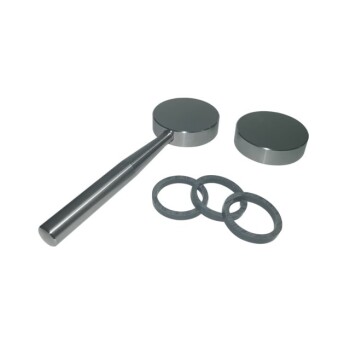X-ray fluorescence (XRF) is a versatile and non-destructive analytical technique used to determine the elemental composition of materials.
This technology is invaluable in various scientific and industrial applications due to its ability to quickly and accurately identify and quantify elements in a sample without altering it.
XRF is particularly useful in fields such as archaeology, metallurgy, recycling, and environmental testing, where preserving the integrity of the sample is crucial.
What is the Purpose of XRF? 5 Key Benefits and Applications Explained

1. Non-Destructive Analysis
Preservation of Sample Integrity: XRF allows for the analysis of a material without extracting or altering it.
This is achieved by measuring the fluorescent radiation emitted from the sample when bombarded with X-rays, ensuring that the sample remains intact for further studies or use.
Application in Artifact Analysis: In archaeology, XRF is used to determine the chemical composition of artifacts without causing any damage, which is essential for preserving historical and cultural heritage.
2. Multi-Element Detection
Comprehensive Elemental Analysis: XRF can detect multiple elements in a sample simultaneously, making it suitable for analyzing complex material systems.
This capability is particularly useful in industries like metallurgy and recycling, where identifying various alloy components is crucial.
Efficiency in Industrial Settings: The ability to analyze multiple elements quickly enhances productivity and efficiency in industrial applications, such as quality control in metal manufacturing.
3. High-Speed Analysis
Rapid Testing: XRF technology enables the rapid analysis of a large number of samples in a short time, which is beneficial in settings where quick results are necessary for decision-making, such as in mining and environmental testing.
Real-Time Information: The speed of XRF analysis is particularly advantageous in field applications, where immediate data can guide immediate actions, such as in geological exploration or environmental remediation.
4. Low Interference
Accurate Results: Each element emits a unique X-ray fluorescence signal, reducing interference between different elements in complex samples.
This ensures high accuracy in the analysis, which is critical in applications like positive material identification (PMI) and precious metal analysis.
Dependable Quality Assurance: In industries such as alloy fabrication and recycling, the low interference feature of XRF provides a reliable method for quality assurance, ensuring that the final product meets the required standards.
5. Versatility in Applications
Broad Range of Industries: XRF is used across various fields, including archaeology, metallurgy, recycling, environmental testing, and geology.
Its versatility makes it a standard tool in many analytical labs worldwide.
Customizable Solutions: Whether in a laboratory setting or in the field with portable, handheld devices, XRF can be adapted to meet the specific needs of different applications, providing flexibility and utility.
6. Limitations
Inability to Detect Light Elements: XRF cannot detect elements lighter than magnesium, such as hydrogen, carbon, nitrogen, and oxygen, due to the weak nature of their X-ray signals.
Lack of Chemical Structure Information: While XRF provides information on the elemental composition of a sample, it does not reveal the chemical structure or molecular bonding of the elements.
In conclusion, XRF is a powerful and versatile analytical tool that offers numerous advantages, including non-destructive analysis, multi-element detection, high-speed analysis, and low interference.
Its applications span a wide range of industries, making it an essential instrument in modern scientific research and industrial detection.
However, it is important to consider its limitations, particularly in detecting light elements and providing chemical structure information.
Continue exploring, consult our experts
Immerse your research with the precision of XRF technology from KINTEK SOLUTION.
Unveil the elements within your samples without damage, and benefit from our comprehensive, high-speed analysis for unparalleled accuracy.
Harness the versatility of XRF across various industries, from archaeology to metallurgy.
Let our expertise transform your analytical challenges into actionable insights.
Don't miss out on the KINTEK advantage – reach out today and elevate your lab's capabilities with our cutting-edge solutions!












